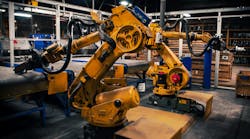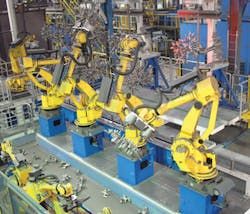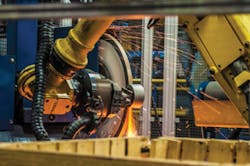Robots: GF Automates, ReStarts Automotive Foundry and Automating for Safety and Productivity at Bremen Casting Inc.
Georg Fischer AG’s GF Automotive started up a new production line at its ductile iron foundry in Mettmann, Germany, centering on a robotic pouring operation. The estimated $46.5-million modernization took 13 months to complete. The contractor and equipment suppliers for the improvement project were not reported. Earlier this year, ABP Induction noted it had installed a new, 90-metric ton channel furnace and 1,200-MW power supply at Mettmann.
The Mettmann foundry was established over 100 years ago, and produces up to 200,000 metric tons/year of ductile iron automotive and commercial vehicle parts, including longitudinal bearings, steering knuckles, suspension arms, camshafts, rear-axle casings, and wheel hubs. GF Automotive noted that Mettmann’s castings are incorporated into the new Audi A3 and the VW Golf.
The new Aeration Molding Robotpouring (AMR) production line addresses automotive customers’ demand for lighter parts, according to GF Automotive. It has a capacity to pour up to 60,000 metric tons/year of ductile iron parts, including parts that the operator describes as "exceptionally fine-featured, and thus lightweight."
The AMR line has 20 robots pouring ductile iron, reducing the labor requirements, and also sets "a benchmark in terms of energy efficiency," the foundry operator stated. A built-in heat-recovery system converts waste heat to warm the plant, and state-of-the-art electro motors are used to cut energy consumption by over 40%.
"The new, highly automated and very much eco-friendly manufacturing line yet again substantially boosts product quality and replaces two older facilities, thus decisively enhancing our competitiveness," stated Yves Serra, CEO of Georg Fischer AG.
Bremen Castings Inc.
Bremen Castings Inc. placed an order recently for four new robotic arms to be installed in its machining operation. The Indiana gray and ductile iron foundry regularly emphasizes plant safety — recently, it passed 500 days in operation without a lost-time accident (LTA) — and the new Fanuc robots are seen as supporting the company’s safety and productivity efforts.
"Safety is our first priority," noted BCI president J.B. Brown, "so it is essential that we protect our employees, first and foremost. This new equipment not only adds a new level of safety but it increases productivity. We are very excited to have this fully-installed in our foundry."
The Fanuc Robotics R2000A has six axes of motion in its arm/wrist assemblage, making it an effective tool for Bremen Castings’ automated grinding processes. The foundry installed two such robots in 2011 and it indicated these devices have "significantly" improved product consistency and standard hours of operations for automatic grinding.
As such, BCI now plans to install four more robots. Once the new units are in place the plant will have three robotic cells with six Fanuc R2000A robots, and four grinders in each work cell. Operators will load castings onto belts that will deliver castings to the cells, where the finish grinding will be completed and a robot will deliver the finished item to a container for delivery.
The set-up will allow Bremen to grind heavy castings without increasing operator fatigue risk of injury. The foundry indicated it is working now to outfit its product set-ups for all castings to match the specifications of the Fanuc robots, to increase efficiency, consistency and on-time delivery.
"We have an incredible staff that come to work every single day," according to Brown, describing the recent plant-safety accomplishment, "but we’ve implemented strategies and procedures to make sure that everyone is accountable for everyone’s safety while at work.
"One example is that we require all employees to file 'near miss’ reports," Brown continued. "So, if there is a cable in the way or a slippery step, the employee is responsible for moving it and filing a report to inform upper management of the issue. This example is then looked at by our executive team to determine how we can possibly change things in the future to prevent a possible situation from happening."
Lost-time hours and recordable incidents are measured according to the U.S. Dept. of Labor’s Occupational Health and Safety Administration reporting requirements. OSHA requires plants to maintain records (OSHA Recordable Incident) on a range of work-related injuries and illnesses, including: restricted work activity (RWA); lost work activity (days away from work); medical treatment beyond first aid (OSHA recordable, non-lost time); transfer to another job due to injury; loss of consciousness; and fatality related to work. Injuries that require first aid and "near misses" are not OSHA Recordable.
The last LTA at BCI happened more than a year ago, the company noted; an employee missed one full shift, but since then the foundry and machine shop have been accident-free. It indicated that now it is eyeing 1 million man-hours and two years of operation without LTAs as its next milestone.












